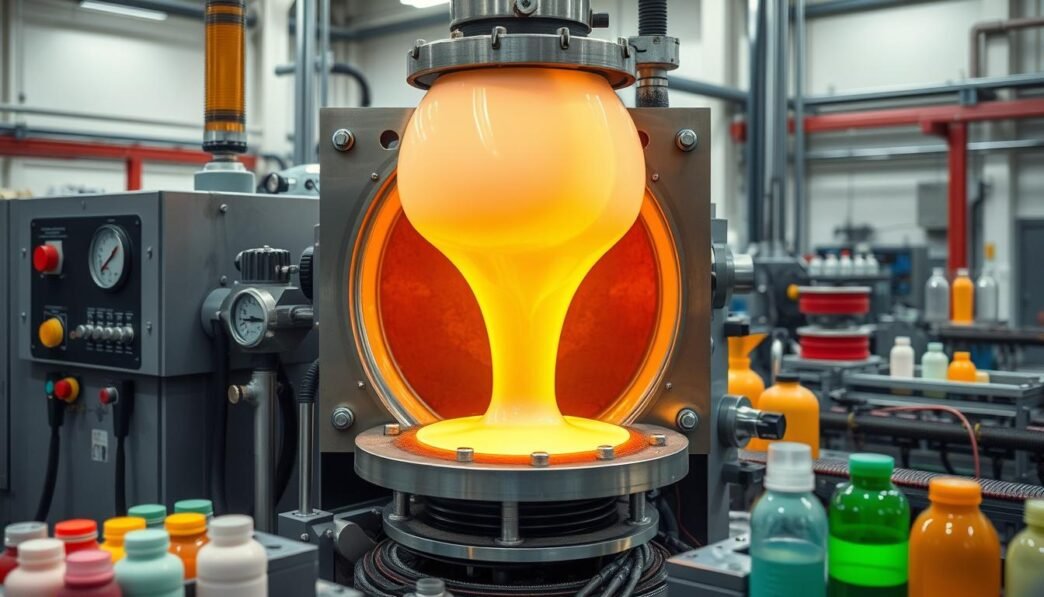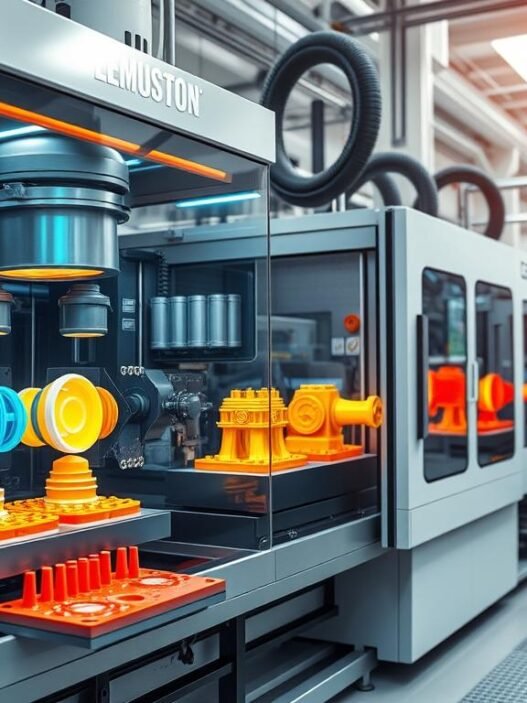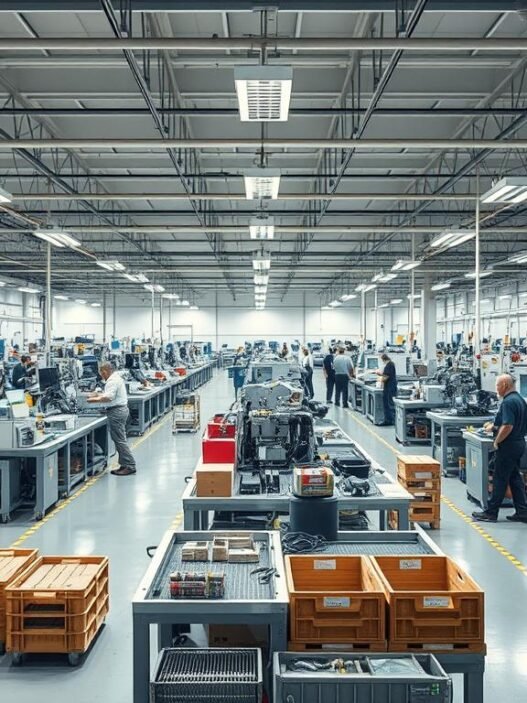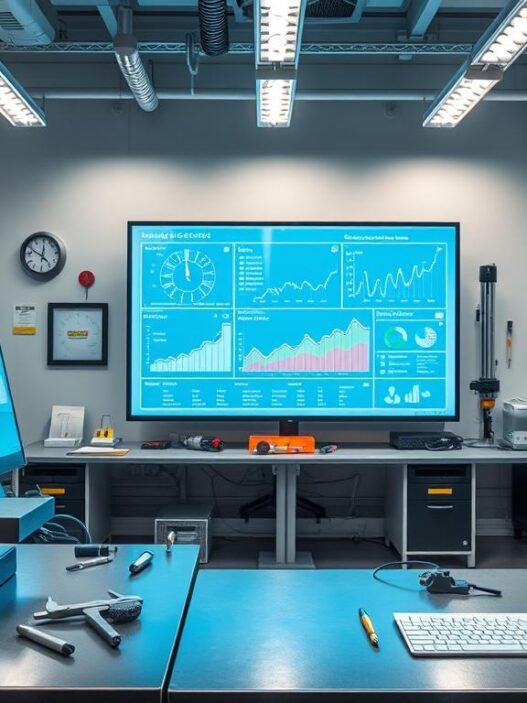In the world of plastic making, a new method has changed how we make hollow items – blow molding. This method uses air and heat to shape plastic. It’s key in making many things we use every day, like bottles and car parts.
So, what is blow molding? How does it make plastic products so precise and efficient? Let’s explore the world of blow molding and see how it works its magic.
Key Takeaways
- Blow molding is a special way to make plastic items using air pressure.
- This method is used in many fields, like packaging and cars.
- It’s great because it’s fast, flexible, and saves money.
- The process heats a plastic tube and then blows it into shape.
- It makes many types of hollow plastic items, from bottles to medical tools.
What is Blow Molding?
Definition and Overview of Blow Molding Process
Blow molding is a key method for making hollow plastic items. It uses a heated plastic tube, called a parison or preform, which is blown into a mold. The tube is placed between two mold halves, and air is added to it.
This makes the plastic expand and fit the mold’s shape. The definition of blow molding is about making hollow plastic items by blowing a heated plastic tube into a mold.
This method is great for making lots of thin-walled plastic products. Examples include bottles, containers, and other hollow items.
The blow molding process includes a few steps:
- The parison, or heated plastic tube, is placed between the two mold halves.
- Compressed air is then injected into the parison, causing it to expand and conform to the shape of the mold.
- The molded product is then cooled, trimmed, and ejected from the mold.
This technique is used to make many types of hollow plastic products. It’s used for everything from simple containers to complex car parts. This makes it very important in the plastics industry.
“Blow molding is a cost-effective alternative to injection molding, with cheaper production and machinery costs.”
The way how blow molding works makes it very popular among manufacturers. It helps the plastics industry grow and innovate.
Blow Molding: Unraveling the Process
The blow molding process is a fascinating mix of plastic, molds, and air pressure. It turns molten plastic into detailed hollow shapes. These shapes are used in many industries. Let’s explore how blow molding machines work and the steps to create these plastic marvels.
Unfolding the Blow Molding Process
The blow molding process has four main stages:
- Material Preparation: First, the right plastic material, like HDPE, is chosen. It’s then heated until it’s soft and easy to shape.
- Parison Formation: The plastic is molded into a tube called the parison or preform. This is the first step towards the final product.
- Inflation: The parison is placed in two mold halves. Air is blown into it, making the plastic expand and take the mold’s shape.
- Cooling and Ejection: After that, the product cools down. Any extra plastic is cut off. Then, the finished item is taken out of the mold, ready for use.
This cycle of steps creates the plastic items we see every day. From simple water bottles to complex car parts, it’s all thanks to blow molding.
Knowing the blow molding process shows us the creativity and accuracy needed. It turns raw plastic into useful and attractive items that fit perfectly into our lives.
Types of Blow Molding
The world of blow molding is full of different techniques. Each has its own special features and uses. From Extrusion Blow Molding (EBM) to Injection Blow Molding (IBM) and Injection Stretch Blow Molding (ISBM), the right process depends on the product size, shape, plastic type, and needed quality.
Extrusion Blow Molding (EBM): This method is very common. It works with many types of plastics, especially polyethylene (PE) and polypropylene (PP). EBM comes in continuous and intermittent types, each with its own benefits.
Injection Blow Molding (IBM): It’s great for making lots of hollow glass and plastic items. IBM has three steps: injection, blowing, and ejection. It can be done in one or two stages, depending on what’s needed.
Injection Stretch Blow Molding (ISBM): This method makes preforms and then heats, blows, and stretches them. The preforms are heated and then blown into bottles using air and metal molds.
| Blow Molding Technique | Key Characteristics | Typical Applications |
|---|---|---|
| Extrusion Blow Molding (EBM) | – Accommodates a wide variety of resin types – Includes continuous and intermittent variations |
Milk bottles, automotive air ducts, fluid reservoirs, detergent bottles, sporting goods, juice bottles, medical products, carrying cases |
| Injection Blow Molding (IBM) | – High-volume production of hollow glass and plastic objects – Single-stage or two-stage process |
Plastic bottles, containers, and other hollow products |
| Injection Stretch Blow Molding (ISBM) | – Involves molding preforms and subsequent heating, blowing, and stretching – Allows for creating bottles using less material than regular IBM |
PET bottles, containers, and other hollow plastic products |
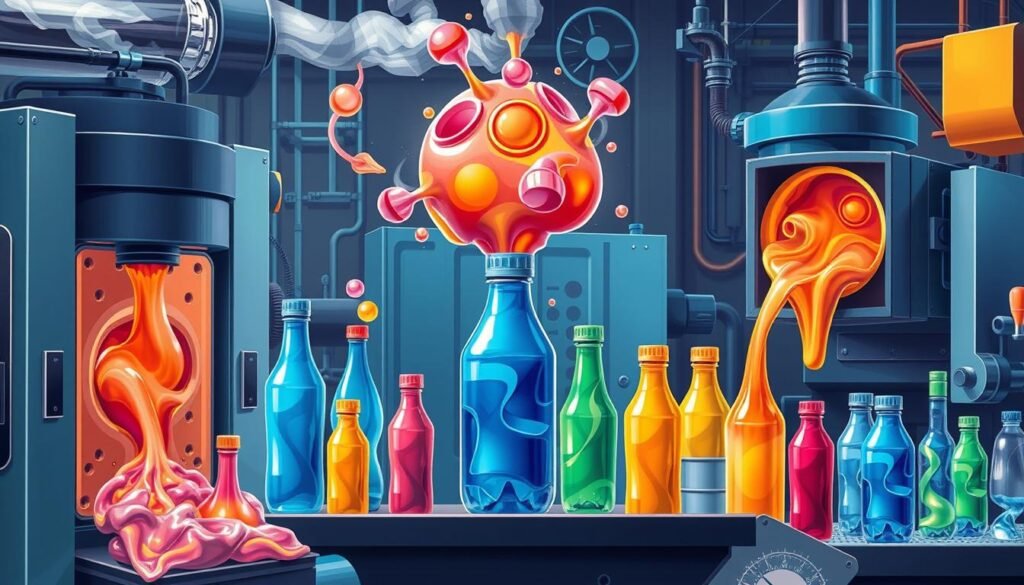
Each blow molding technique has its own strengths and is best for certain products. Knowing the differences helps choose the right process for a product.
Injection Blow Molding: Precision and Versatility
In the world of plastic making, injection blow molding (IBM) is a standout. It mixes the best of injection molding and blow molding. This makes it great for making detailed, high-quality plastic items with perfect accuracy.
Exploring the Advantages and Applications of Injection Blow Molding
The injection blow molding starts with melting plastic pellets. Then, the melted plastic is pushed into a mold to form a preform. Next, the preform goes into a blow mold where air shapes the final product.
This method makes hollow plastic items with very tight tolerances. They are perfect for many uses, like beverage containers, storage tanks, automotive parts, and consumer goods.
Injection blow molding is known for its design flexibility. It lets makers create complex shapes and details. It’s also great for making lots of items at once, which saves money for big projects.
| Advantages of Injection Blow Molding | Common Products |
|---|---|
|
|
As the plastic making world keeps changing, injection blow molding stays a key method. It lets makers create precise products that meet market needs.
Extrusion Blow Molding: Efficiency and Affordability
Extrusion Blow Molding (EBM) has been around since the 1950s. It starts by heating plastic to make a preform, or parison. Then, it seals one end and blows it up with air to fit the mold.
EBM is used in many fields like cars, packaging, and more. It makes things like bottles, containers, and even ducts.
The most common plastics are polyethylene (PE), polypropylene (PP), and PVC. Machines can be shuttle or rotary, with rotary being faster. They have 6-10 stations and are quick in making lots of products. This method is efficient and affordable, making it a favorite for many.
| Advantages of Extrusion Blow Molding | Products Made with Extrusion Blow Molding |
|---|---|
|
|
Even though EBM has some design limits, it’s still a top choice. It’s great for making lots of products fast and cheap. This makes it perfect for many industries.
“Extrusion blow molding offers potential cost savings compared to other molding processes as it only requires low-pressure air and does not need a preform, resulting in lower mold and auxiliary costs.”
Stretch Blow Molding: Enhancing Strength and Durability
Understanding the Benefits of Stretch Blow Molding
Stretch blow molding (SBM) is a special blow molding technique. It stretches the preform before inflation. This step boosts the product’s strength and durability.
SBM can be done in one or two stages. It’s great for making many things, like bottles and car parts.
The benefits of SBM are many. It improves barrier properties and container strength. It also makes containers clearer and more durable.
SBM can make containers lighter by 10 to 15%. This saves money without sacrificing quality.
SBM lets you make different bottle shapes. This meets many packaging needs. It’s perfect for making lots of products, like soda bottles.
This method also saves money by using preforms. It makes containers stronger, too. This makes SBM a top choice in packaging today.

“Stretch blow molding is a game-changer in the packaging industry, delivering high-quality, durable containers with exceptional design flexibility and cost-effectiveness.”
Advantages of Blow Molding
Blow molding has many benefits that make it a top choice for manufacturers. It’s perfect for high-volume production because it’s automated and fast. This means it can make lots of products quickly, saving money.
It also offers design versatility. This means it can create complex shapes and designs. These are hard or impossible with traditional methods. This flexibility is great for many industries.
Another plus is its cost-effective tooling requirements. This is especially true for extrusion blow molding. It uses lower pressures, which means less tooling costs. This is good for startups or projects with tight budgets.
High-Volume Production, Design Flexibility, and Cost-Effectiveness
In short, blow molding is great for high-volume production, design versatility, and cost-effectiveness. These traits make it a strong contender for many industries.
Blow Molding Applications and Industries
Blow molding is a versatile technique used in many industries. It’s used in the food and beverage, automotive, and pharmaceutical sectors. This method has changed how products are made and packaged.
In the food and beverage industry, it’s used for plastic bottles and containers. The pharmaceutical industry uses it for pill bottles and medication packaging.
Automotive makers use blow molding for parts like fluid reservoirs and air ducts. The cosmetic and personal care industry uses it for beauty product packaging.
Its design flexibility and cost-effectiveness make it popular. It allows for producing a wide range of products efficiently.
“Blow molding has revolutionized the way we manufacture products, offering unparalleled design flexibility and cost-effectiveness across a wide range of industries.”
Blow molding is used for household items and industrial components. It has changed the product landscape. It offers innovative solutions for today’s needs.
Conclusion
Blow molding is a key plastic-making method used in many fields. It’s known for its high-volume production, design flexibility, and cost savings. This makes it essential for making a wide range of hollow plastic items, from common bottles to complex car parts.
The article looked at different types of blow molding, like injection and extrusion blow molding. Each type has its own benefits and uses. It also talked about the materials used, such as HDPE and PET, showing how versatile blow molding is.
As technology improves and green manufacturing becomes more important, blow molding’s role will grow. Businesses can use this knowledge to make innovative, affordable products. This meets the changing needs of customers and the market.






